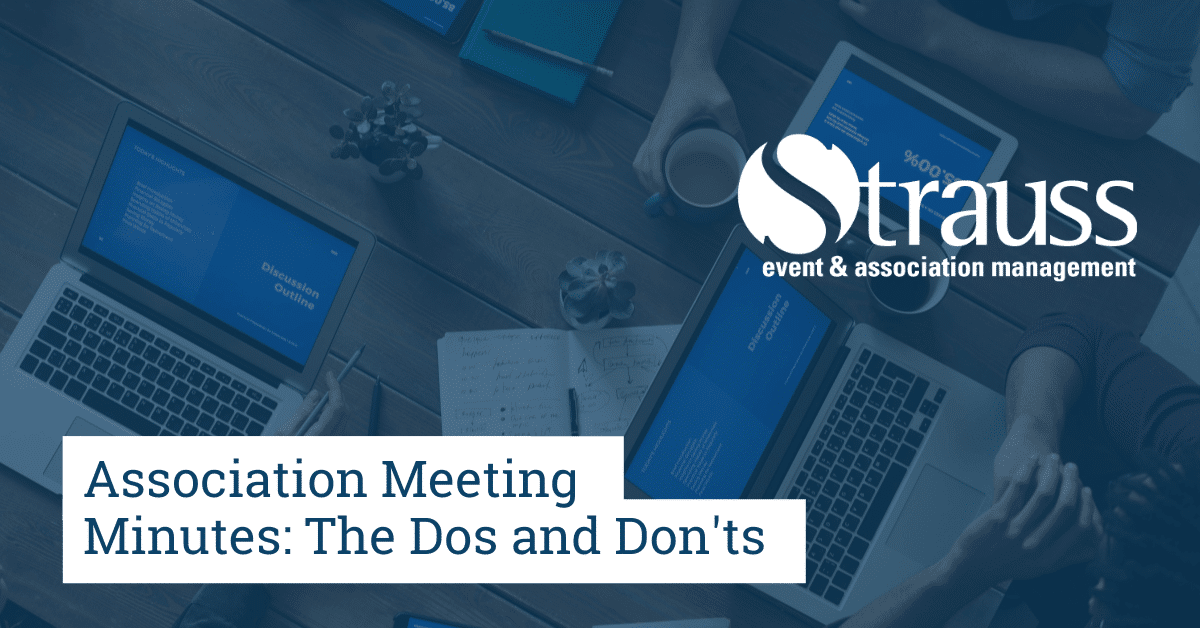One thing all associations have in common is the recording of meeting minutes. Minutes are an official record of actions that the board or committee took at a meeting. Minutes are taken at all meetings whether they are board, committee, or member meetings. These meetings are held in-person, via video call, or via conference call.
In this article I will go over what should be and should not be included when it comes to taking association meeting minutes – the do’s and don’ts.
The Don’ts
Let’s start off with what not to include in the minutes.
Don’t capture every detail of each member speaking.
Trying to write down every word and detail of a speaker is not possible when you are in a meeting. One of the hardest parts of taking minutes is knowing what needs to be included. What you need to listen carefully for are large-scale decisions, action items, problems, and any solutions proposed.
Don’t wait to type up the meeting minutes.
Record the meeting minutes as they are happening so that they can be documented accurately while everything is still fresh in your mind. The longer you wait, the less accurate the minutes become. I recommend typing the minutes on a laptop during the meeting. If you do not have access to a laptop, handwriting in a notebook works just as well. With one of the associations that I work with, all board meetings are held at a local restaurant, so instead of hauling around my laptop to the meeting I bring a small notebook to take the down the minutes. I then type them up once I get back to the office that day.
Don’t include how each member voted.
All board meetings have items that need to be voted on. You should name who made and seconded each motion, but you should not include how the other individuals voted. A motion would look like this: “Motion made by, seconded by, all in favor, carried.” If a tally is required you do not need to mention how each person voted simply note the number of those who are in favor, those against, and those who abstained. If there was a debate, it should be mentioned. However, do not write all the points, simply note ‘discussion took place regarding…’
Don’t add member opinions, side comments or discussions.
Side comments and discussions are bound to happen during meetings, but they should not be recorded. Board minutes should focus on decisions, not discussion. Should a board member bring up an issue that is worth clarifying but does not appear in the agenda, it doesn’t normally need to be detailed. Instead, note that directors took the time to discuss items that were not on the agenda.
Don’t include documents or presentations.
You should mention presented materials in your board minutes. You do not need to go into great detail about its content. For example, ‘the financial statements to the end of September were reviewed as distributed’. If there is discussion or a question about an item in the stated document that should be noted.
Read my colleague’s recent article on Utilizing the Strengths of Virtual and In-Person Meetings.
The Do’s
There is no “correct way” to type up meeting minutes, and each association has its own preferences for what they prefer. But there are several details every board and/or committee needs to record during meetings.
Do record names of participants in the meeting.
Record participants as they enter the room. For conference call meetings, have the chair take roll call. As quorum is required to make any decisions, you’ll want to make sure you didn’t miss anyone. The minutes should note those in attendance, any regrets, and staff members.
Do include all logistical details.
Date and time, location, and type of meeting. See the example below:
XYZ Association
BOARD OF DIRECTORS MEETING
Date: Thursday, January 5 2020
Time: 12:00 p.m.
Location: Conference Room
Do record decisions on motions and action items.
Record motions and action items as soon as they occur to be sure you are recording them accurately. If you are unsure of the wording for the motion, ask for clarification.
Do record the meeting.
For conference or video calls it is a good idea to have a recording in case you missed something during the call as it can be hard to hear what each person is saying. If you record the meeting, let the participants know that they will be recorded.
Taking meeting minutes is not always an easy job, but I hope my above list of do’s and don’ts help make the task a bit easier!
For more tips on taking meeting minutes view a past article of mine here.

